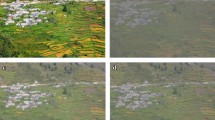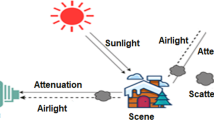Abstract
Removing the smog from digital images is a challenging pre-processing tool in various imaging systems. Therefore, many smog removal (i.e., desmogging) models are proposed so far to remove the effect of smog from images. The desmogging models are based upon a physical model, it means it requires efficient estimation of transmission map and atmospheric veil from a single smoggy image. Therefore, many prior based restoration models are proposed in the literature to estimate the transmission map and an atmospheric veil. However, these models utilized computationally extensive minimization of an energy function. Also, the existing restoration models suffer from various issues such as distortion of texture, edges, and colors. Therefore, in this paper, a convolutional neural network (CNN) is used to estimate the physical attributes of smoggy images. Oblique gradient channel prior (OGCP) is utilized to restore the smoggy images. Initially, a dataset of smoggy and sunny images are obtained. Thereafter, we have trained CNN to estimate the smog gradient from smoggy images. Finally, based upon the computed smog gradient, OGCP is utilized to restore the still smoggy images. Performance analyses reveal that the proposed CNN-OGCP based desmogging model outperforms the existing desmogging models in terms of various performance metrics.
Similar content being viewed by others
References
Li C, Guo J, Cong R, Pang Y, Wang B. Underwater image enhancement by dehazing with minimum information loss and histogram distribution prior. IEEE Transactions on Image Processing, 2016, 25(12): 5664–5677
Nnolim U A. Partial differential equation-based hazy image contrast enhancement. Computers & Electrical Engineering, 2018, 72: 670–681
Kim J H, Jang W D, Sim J Y, Kim C S. Optimized contrast enhancement for real-time image and video dehazing. Journal of Visual Communication and Image Representation, 2013, 24(3): 410–425
Kim K, Kim S, Kim K S. Effective image enhancement techniques for fog-affected indoor and outdoor images. IET Image Processing, 2018, 12(4): 465–471
Shi Z, Feng Y, Zhao M, Zhang E, He L. Let you see in sand dust weather: a method based on halo-reduced dark channel prior dehazing for sanddust image enhancement. IEEE Access, 2019, 7: 116722–116733
Lai Y, Chen Y, Chiou C, Hsu C. Single-image dehazing via optimal transmission map under scene priors. IEEE Transactions on Circuits and Systems for Video Technology, 2015, 25(1): 1–14
Bui T M, Kim W. Single image dehazing using color ellipsoid prior. IEEE Transactions on Image Processing, 2018, 27(2): 999–1009
Yu T, Riaz I, Piao J, Shin H. Real-time single image dehazing using block-to-pixel interpolation and adaptive dark channel prior. IET Image Processing, 2015, 9(9): 725–734
Golts A, Freedman D, Elad M. Unsupervised single image dehazing using dark channel prior loss. IEEE Transactions on Image Processing, 2020, 29: 2692–2701
Zhu M, He B, Wu Q. Single image dehazing based on dark channel prior and energy minimization. IEEE Signal Processing Letters, 2018, 25(2): 174–178
Xiao J, Zhu L, Zhang Y, Liu E, Lei J. Scene-aware image dehazing based on sky-segmented dark channel prior. IET Image Processing, 2017, 11(12): 1163–1171
Singh D, Kumar V, Kaur M. Single image dehazing using gradient channel prior. Applied Intelligence, 2019, 49(12): 4276–4293
Bala J, Lakhwani K. Single image desmogging using oblique gradient profile prior and variational minimization. Multidimensional Systems and Signal Processing, 2020, 31: 1259–1275
Zhao D, Xu L, Yan Y, Chen J, Duan L Y. Multi-scale optimal fusion model for single image dehazing. Signal Processing: Image Communication, 2019, 74: 253–265
Jiang Y, Sun C, Zhao Y, Yang L. Image dehazing using adaptive bichannel priors on superpixels. Computer Vision and Image Understanding, 2017, 165: 17–32
Wang Y, Huang T Z, Zhao X L, Deng L J, Ji T Y. A convex single image dehazing model via sparse dark channel prior. Applied Mathematics and Computation, 2020, 375: 125085
Gui B, Zhu Y, Zhen T. Adaptive single image dehazing method based on support vector machine. Journal of Visual Communication and Image Representation, 2020, 70: 102792
Yin S, Wang Y, Yang Y H. A novel image-dehazing network with a parallel attention block. Pattern Recognition, 2020, 102: 107255
Liang Z, Wang Y, Ding X, Mi Z, Fu X. Single underwater image enhancement by attenuation map guided color correction and detail preserved dehazing. Neurocomputing, 2021, 425: 160–172
Zhang J, Wang X, Yang C, Zhang J, He D, Song H. Image dehazing based on dark channel prior and brightness enhancement for agricultural remote sensing images from consumer-grade cameras. Computers and Electronics in Agriculture, 2018, 151: 196–206
Emberton S, Chittka L, Cavallaro A. Underwater image and video dehazing with pure haze region segmentation. Computer Vision and Image Understanding, 2018, 168: 145–156
Xiao J, Shen M, Lei J, Zhou J, Klette R, Sui H. Single image dehazing based on learning of haze layers. Neurocomputing, 2020, 389: 108–122
Guo F, Zhao X, Tang J, Peng H, Liu L, Zou B. Single image dehazing based on fusion strategy. Neurocomputing, 2020, 378: 9–23
Gao Y, Li Q, Li J. Single image dehazing via a dual-fusion method. Image and Vision Computing, 2020, 94: 103868
Khan H, Sharif M, Bibi N, Usman M, Haider S A, Zainab S, Shah J H, Bashir Y, Muhammad N. Localization of radiance transformation for image dehazing in wavelet domain. Neurocomputing, 2020, 381: 141–151
Borkar K, Mukherjee S. Single image dehazing by approximating and eliminating the additional airlight component. Neurocomputing, 2020, 400: 294–308
Galdran A. Image dehazing by artificial multiple-exposure image fusion. Signal Processing, 2018, 149: 135–147
Singh D, Kumar V. A novel dehazing model for remote sensing images. Computers & Electrical Engineering, 2018, 69: 14–27
Yuan F, Zhou Y, Xia X, Shi J, Fang Y, Qian X. Image dehazing based on a transmission fusion strategy by automatic image matting. Computer Vision and Image Understanding, 2020, 194: 102933
Wang W, He C, Xia X G. A constrained total variation model for single image dehazing. Pattern Recognition, 2018, 80: 196–209
Alajarmeh A, Salam R, Abdulrahim K, Marhusin M, Zaidan A, Zaidan B. Real-time framework for image dehazing based on linear transmission and constant-time airlight estimation. Information Sciences, 2018, 436: 108–130
Singh D, Kumar V. Dehazing of outdoor images using notch based integral guided filter. Multimedia Tools and Applications, 2018, 77(20): 27363–27386
Basavegowda H S, Dagnew G. Deep learning approach for microarray cancer data classification. CAAI Transactions on Intelligence Technology, 2020, 5(1): 22–33
Singh D, Kumar V. Single image defogging by gain gradient image filter. Science China Information Sciences, 2019, 62(7): 79101
Osterland S, Weber J. Analytical analysis of single-stage pressure relief valves. International Journal of Hydromechatronics, 2019, 2(1): 32–53
Wang R, Yu H, Wang G, Zhang G, Wang W. Study on the dynamic and static characteristics of gas static thrust bearing with micro-hole restrictors. International Journal of Hydromechatronics, 2019, 2(3): 189–202
Qi G, Wang H, Haner M, Weng C, Chen S, Zhu Z. Convolutional neural network based detection and judgement of environmental obstacle in vehicle operation. CAAI Transactions on Intelligence Technology, 2019, 4(2): 80–91
Singh D, Kumar V, Kaur M. Image dehazing using window-based integrated means filter. Multimedia Tools and Applications, 2020, 79: 34771–34793
Kaur M, Singh D, Kumar V, Sun K. Color image dehazing using gradient channel prior and guided l0 filter. Information Sciences, 2020, 521: 326–342
Singh D, Kumar V. Image dehazing using moore neighborhood-based gradient profile prior. Signal Processing: Image Communication, 2019, 70: 131–144
Wiens T. Engine speed reduction for hydraulic machinery using predictive algorithms. International Journal of Hydromechatronics, 2019, 2(1): 16–31
Levin A, Lischinski D, Weiss Y. A closed form solution to natural image matting. In: Proceedings of IEEE Computer Society Conference on Computer Vision and Pattern Recognition. 2006
Singh D, Kumar V, Kaur M. Classification of COVID-19 patients from chest CT images using multi-objective differential evolution-based convolutional neural networks. European Journal of Clinical Microbiology & Infectious Diseases, 2020, 39(7): 1379–1389
Ding R, Dai L, Li G, Liu H. TDD-net: a tiny defect detection network for printed circuit boards. CAAI Transactions on Intelligence Technology, 2019, 4(2): 110–116
Kaur M, Kumar V. Beta chaotic map based image encryption using genetic algorithm. International Journal of Bifurcation and Chaos, 2018, 28(11): 1850132
Kaur M, Singh D, Uppal R S. Parallel strength pareto evolutionary algorithm-ii based image encryption. IET Image Processing, 2019, 14(6): 1015–1026
Gupta A, Singh D, Kaur M. An efficient image encryption using non-dominated sorting genetic algorithm-III based 4-D chaotic maps. Journal of Ambient Intelligence and Humanized Computing, 2020, 11(3): 1309–1324
Kaur M, Singh D, Sun K, Rawat U. Color image encryption using non-dominated sorting genetic algorithm with local chaotic search based 5D chaotic map. Future Generation Computer Systems, 2020, 107: 333–350
Kaur M, Kumar V, Li L. Color image encryption approach based on memetic differential evolution. Neural Computing and Applications, 2019, 31(11): 7975–7987
Acknowledgements
The authors would like to thank their organizations especially Teerthanker Mahaveer University, Moradabad, India to provide suitable time and resources to successfully finish this research work.
Author information
Authors and Affiliations
Corresponding author
Additional information
Ashok Kumar received the PhD in Computer Science from Gurukula Kangri Vishwavidyalaya Haridwar, India in 2019 and Master’s degree in Computer Applications from Dr. Bhim Rao Ambedkar University Agra, India in 2002. He is an associate professor at the College of Computing Science and Information Technology, Teerthanker Mahaveer University Moradabad, India. He has authored 20 research papers in the International/National Journals and Conferences.
Arpit Jain has competent, diligent & result oriented professional, offering over 16+ years of exposure across teaching in the field of Computer Science; currently spearheading as associate professor with Teerthanker Mahaveer University, India. He received the B Tech degree from UPTU, India in 2006, the M Tech degree from Shobhit Universirt, India and the PhD degrees from the Teerthanker Mahaveer University, India, all in Computer Science and Engineering. His current research interests are in the area of image processing, chip implementation by introducing the concept of Machine learning.
Electronic supplementary material
Rights and permissions
About this article
Cite this article
Kumar, A., Jain, A. Image smog restoration using oblique gradient profile prior and energy minimization. Front. Comput. Sci. 15, 156706 (2021). https://doi.org/10.1007/s11704-020-9305-8
Received:
Accepted:
Published:
DOI: https://doi.org/10.1007/s11704-020-9305-8




